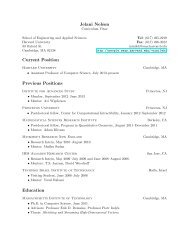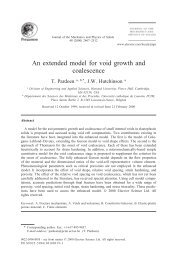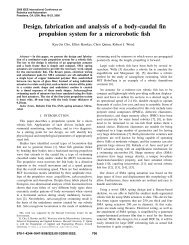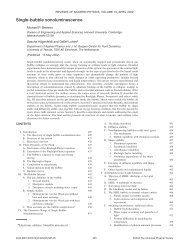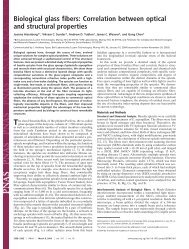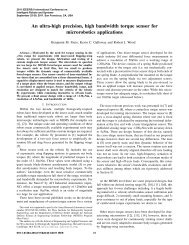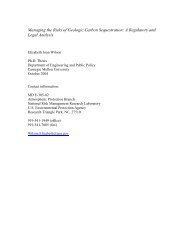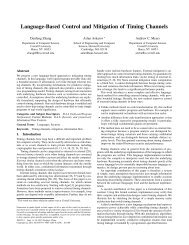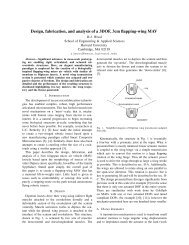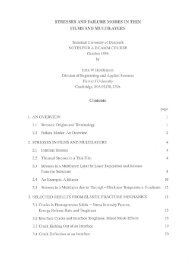CMOS RF Biosensor Utilizing Nuclear Magnetic Resonance
CMOS RF Biosensor Utilizing Nuclear Magnetic Resonance
CMOS RF Biosensor Utilizing Nuclear Magnetic Resonance
You also want an ePaper? Increase the reach of your titles
YUMPU automatically turns print PDFs into web optimized ePapers that Google loves.
1638 IEEE JOURNAL OF SOLID-STATE CIRCUITS, VOL. 44, NO. 5, MAY 2009<br />
To avoid the use of a switch in the receiving mode, we devised<br />
a new, differential matching network of Fig. 11(b). In the<br />
transmission mode, the switches next to the PA are turned on,<br />
and the PA is connected to the coil through the inductors<br />
and capacitors<br />
[Fig. 11(c)]. In the receiving mode,<br />
the switches are off, effectively making the inductors disappear,<br />
and the LNA is connected to the coil, whose impedance is modified<br />
by the capacitors<br />
[Fig. 11(d)]. The first point<br />
of this circuit is that the LNA in the receiving mode and the PA<br />
in the transmitting mode see two different impedances, that is,<br />
in Fig. 11. Thus, one can choose capacitors<br />
and inductors appropriately to provide power matching for the<br />
PA and noise matching for the LNA. Note that the difference<br />
between and arises not merely from the fact that<br />
the transmitting path has additional inductors, but more importantly<br />
from the fact that the impedance of the network of capacitors<br />
and the coil seen from the left is completely different from<br />
that seen from the right, that is,<br />
in Fig. 11. The<br />
second point is that neither lossy switches nor lossy inductors<br />
are present in the receiving mode [Fig. 11(d)], and hence, the<br />
matching network hardly degrades the receiver noise figure.<br />
We now consider how to select capacitor and inductor values<br />
quantitatively. For simplicity, we introduce the following notation:<br />
, , , and<br />
. in Fig. 11(d) is given by<br />
that is, when seen from the coil, the capacitors in Fig. 11(d)<br />
behave like one effective capacitor, whose impedance is to the<br />
right of the symbol. The noise matching condition [see (6)]<br />
for is that the effective capacitor resonates with at .<br />
This condition may be written as<br />
In the transmitting mode,<br />
of Fig. 11(c) is expressed as<br />
(9)<br />
(10)<br />
(11)<br />
For power matching, the real part of should equal the<br />
output resistance of the PA, while its capacitive reactance<br />
is to be resonated out by the inductors :<br />
(12)<br />
(13)<br />
If three conditions (10), (12) and (13) are simultaneously met,<br />
noise and power matching are simultaneously obtained. Since<br />
there are four unknown design parameters ( , , , and ),<br />
we have a large degree of freedom in choosing them.<br />
VI. <strong>CMOS</strong> <strong>RF</strong> TRANSCEIVER IC DESIGN:<br />
OTHER CIRCUIT CONSIDERATIONS<br />
A. Receiver Linearity<br />
Although the planar microcoil is the ultimate part of our<br />
system, it is desirable for the system to be able to accommodate<br />
a variety coils for varying experimental needs. The coil’s<br />
varies widely depending on its geometry and construction:<br />
e.g., while for the planar microcoil, for a<br />
solenoidal microcoil we built. The signal grows with the coil<br />
, especially with the resonance noise matching. To provide<br />
more amplification for a smaller signal, but to ensure that a<br />
larger signal does not enter the nonlinear regime of the mixer, 3<br />
we designed a variable gain amplifier (VGA) following the<br />
LNA (Fig. 5). The receiver linearity is important, as we seek to<br />
accurately extract .<br />
The VGA is depicted in the middle of Fig. 12. It is a differential<br />
common source amplifier with two tunable loads<br />
shown within the two dashed boxes. The VGA’s gain is altered<br />
by tuning the load impedance. Each load has three branches<br />
in parallel. Consider the branch built around transistor .<br />
As the control voltage is increased from zero, the operation<br />
regime of undergoes transitions from turn-off to<br />
pinch-off to triode, decreasing its drain-source resistance,<br />
. Therefore, the first branch serves as a<br />
voltage-controlled load. The second branch behaves essentially<br />
the same way, with decreasing of with increasing ,<br />
but this time, the gate of sees a voltage lower than due to<br />
, thus, the impedance-versus- curve for the second branch<br />
is that for the first branch, but translated along the axis. The<br />
third branch involving three transistors, , , and , also<br />
exhibits the same impedance-versus- curve, but even more<br />
shifted along the axis. By combining the three branches in<br />
parallel, the load impedance is tuned more smoothly over a<br />
wider range of , as compared to the case any single branch is<br />
used alone. The voltage gain tuning range of the VGA is from<br />
0.8 to 22. The VGA’s noise hardly contributes to the receiver<br />
noise figure, as the LNA’s gain is large (41 dB). Therefore, little<br />
noise minimization effort is required for the VGA.<br />
B. RX-TX Switching Scheme<br />
As discussed in Section V-F, to avoid the use of lossy switches<br />
in front of the LNA, in our design the LNA stays connected to<br />
the coil during the and pulse transmissions, e.g.,<br />
Fig. 11(b). In this approach, the large <strong>RF</strong> signal from the PA<br />
will saturate the receiver during the transmission mode. If the<br />
receiver is saturated during the transmission mode, restoration<br />
to its normal operation at the transition to the receiving phase<br />
(e.g., at ) will exhibit a settling behavior over the characteristic<br />
time of the receiver, compromising the initial reception<br />
of the signal.<br />
To address this issue, during the transmission mode, we reduce<br />
the gain of the LNA by closing switch in Fig. 12, preventing<br />
its saturation, and disconnect the rest of the receiver<br />
from the LNA by opening switches and of Fig. 12. Although<br />
and lie in the <strong>RF</strong> signal path, they come after the<br />
3 The input to our mixer can be as large as 10 mV within 5% gain reduction.



